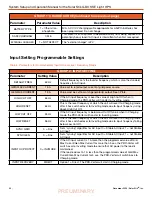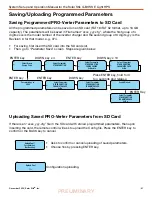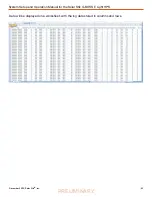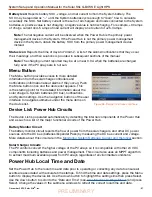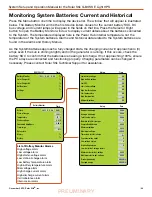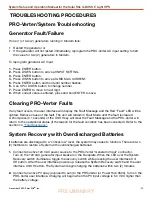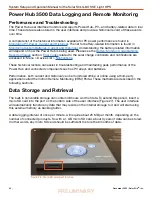
December 2020
|
Solar Stik
®
, Inc.
68
|
System Setup and Operation Manual for the Solar Stik G-BOSS E Light HPS
PRELIMINARY
Monitoring PV Power: Current and Historical
Press the Menu button one time to display the device list. The window that will appear is illustrated
below. Solar Charger #1 and #2 will appear in lines 2–3. Use the Up/Down navigation buttons to
highlight the any of the solar chargers. Press Right or Select to open the menu windows specific
for that solar charger. The window that appears (Solar Charger #1 in the illustration below) provides
an extensive report of the current status for that solar charger. Historical reports for Solar Charger
#1 can be displayed by navigating down to the “Daily History” and “Overall History” lines then
pressing Right or Select. Data reported in those windows are displayed in the illustration below.
Notifications and errors related to solar chargers are found in the Notifications and History Menus.
Note:
Values shown in all of the menu windows will vary.
Solar Charger #1
Time
PV
Battery
Total yield
System yield
Load
Error*
Parallel operation status
Parallel operation
Daily history
Overall history
Device
0.0W
0.0Ah
0.0kWh
0.0kWh
#0 No error
On
Standalone
Off
0.0A
0.00V
0.00V
>
>
>
Daily History
Time
Today
Yield
PV (Pmax/Vmax)
Battery (Vmin/Vmax/Imax)
Charge time (bulk/abs/float)
Last error
0.08kWh
0:03
#No error
0:06
0:23
60.33V
327W
11.9A
29.28V
25.26V
Overall History
Time
Maximum PV
Maximum battery voltage
Minimum battery voltage
Last error
2nd last error
3rd last error
60.33V
29.28V
26.36V
#No error
#No error
#No error
Notifications
Time
No Notifications
DEVICE LIST
Battery Monitor
Time
100% 0.0V
0.0A
Solar Charger #1
Solar Charger #2
Solar Charger #3
Notifications
Settings
>
>
>
>
List of Solar Charger
Notifications
Charger fault
Charge state
Alarm condition
Low voltage alarm
High voltage alarm
Error code*
*See
PV Power: Understanding Reported Values
The Power Hub solar charge controllers report the power they process to the user interface.
Checking these readings often, over extended periods of time, will establish what is “normal” in the
system and give the operator a greater ability to identify and correct deviations from “normal”.
>
>





